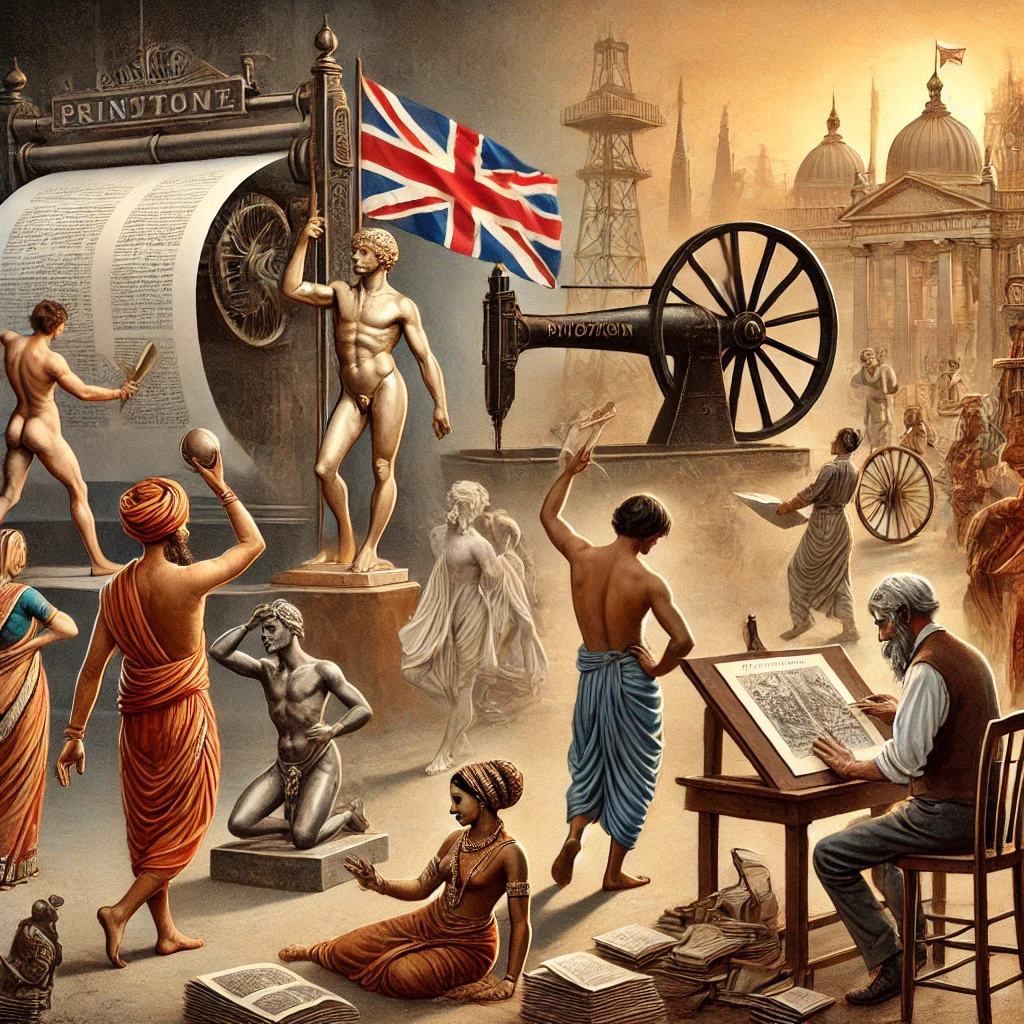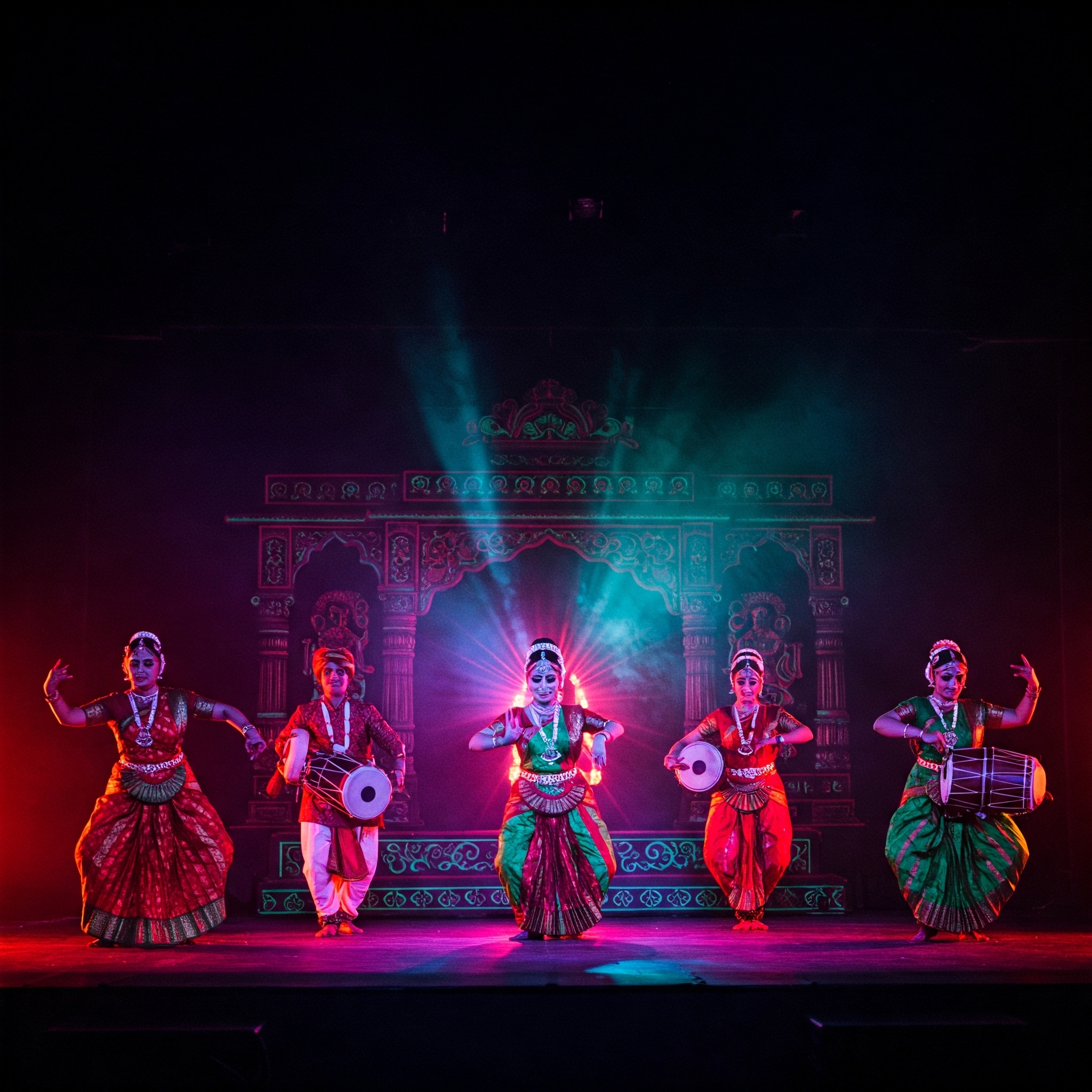The British colonial rule in India, which lasted from 1757 to 1947, profoundly influenced the country’s art, literature, and cultural traditions. The interaction between Indian traditions and European influences led to both disruption and transformation. While colonial rule imposed Western ideals and sought to undermine indigenous cultural expressions, it also inadvertently facilitated new artistic and literary movements that shaped modern Indian identity. This article explores the multifaceted impact of colonial rule on Indian art, literature, and cultural traditions.
1. Impact on Indian Art
Colonial rule brought significant changes to Indian art, both in terms of technique and thematic representation. Traditional artistic styles encountered European realism, resulting in a blend of indigenous and Western art forms.
a. Decline of Traditional Art Forms
- The patronage system that sustained Indian artists under royal courts and temples declined as British rule dismantled princely states.
- Indigenous schools of painting, such as Mughal, Rajput, and Pahari miniatures, suffered due to the lack of royal commissions.
- Traditional artisans, including sculptors and weavers, faced economic hardship as British policies promoted industrialized mass production over handcrafted goods.
b. Emergence of Indo-European Art
- The British introduced European academic painting, emphasizing realism and perspective.
- Indian artists, such as Raja Ravi Varma, adapted Western techniques while maintaining Indian themes, leading to a unique fusion style.
- The British established art schools, such as the Government College of Art in Calcutta, where Indian artists were trained in European artistic methods.
c. Revival Movements and Nationalist Art
- In reaction to Western influence, the Bengal School of Art emerged under Abanindranath Tagore, reviving traditional Indian themes and techniques.
- Art became a medium of resistance, with paintings reflecting nationalist sentiments and cultural pride.
- The Swadeshi movement encouraged a return to indigenous artistic expressions, rejecting colonial aesthetics.
2. Impact on Indian Literature
Colonial rule significantly influenced Indian literature, introducing new genres, themes, and linguistic shifts. The interaction between Indian and European literary traditions gave rise to a modern literary consciousness.
a. Introduction of English Literature and Western Literary Forms
- English became a medium of instruction, exposing Indian writers to European literary traditions.
- The novel, essay, and short story were adopted as new forms of literary expression.
- Writers such as Bankim Chandra Chattopadhyay and Rabindranath Tagore incorporated Western literary techniques while focusing on Indian themes.
b. Rise of Indian Nationalist Literature
- Literature became a tool for political awakening, with writers addressing themes of colonial oppression and nationalism.
- Books like Anandamath (Bankim Chandra Chattopadhyay) and Gitanjali (Rabindranath Tagore) inspired patriotism and cultural revival.
- Newspapers and periodicals in vernacular languages spread nationalist ideas and resistance against British rule.
c. Impact on Regional Languages and Vernacular Literature
- While English literature flourished, vernacular languages also evolved, incorporating new themes and expressions.
- Writers in Hindi, Bengali, Tamil, Marathi, and other languages began engaging with colonial realities, producing literature that reflected socio-political changes.
- Translations of Western classics introduced Indian readers to global literary movements, shaping modern Indian literature.
3. Impact on Cultural Traditions
Colonial rule brought profound shifts in Indian cultural traditions, affecting religion, social customs, and performing arts.
a. Religious and Philosophical Transformations
- British rule challenged Indian religious practices, leading to the emergence of reform movements such as Brahmo Samaj, Arya Samaj, and the Ramakrishna Mission.
- Missionary activities attempted to convert Indians to Christianity, sparking debates on religious identity.
- The fusion of Western and Indian philosophical ideas gave rise to thinkers like Swami Vivekananda, who redefined Hinduism for a modern audience.
b. Changes in Social and Cultural Practices
- The British introduced laws and reforms affecting traditional customs, such as the abolition of sati and the introduction of widow remarriage.
- Western education and social reforms led to the rise of a new middle class that embraced modernity while negotiating with Indian traditions.
- The British-influenced education system emphasized rationalism and scientific inquiry, transforming traditional modes of knowledge transmission.
c. Transformation of Performing Arts
- Traditional dance and music forms faced neglect as colonial authorities promoted European cultural expressions.
- However, movements like the revival of Bharatanatyam, Kathak, and Carnatic music in the 20th century reasserted Indian cultural identity.
- The British introduced theater and opera, leading to the evolution of Indian drama and cinema.
4. Legacy of Colonial Influence on Indian Culture
Despite the exploitative nature of colonial rule, the cultural exchanges between India and the West left a lasting impact:
- The synthesis of Indian and European artistic styles paved the way for modern Indian art.
- The introduction of the printing press revolutionized Indian literature, making books and newspapers widely accessible.
- The blending of Western education with traditional Indian knowledge contributed to intellectual and social reform movements.
- Indian cinema, a major cultural force today, evolved through a combination of indigenous storytelling and Western cinematic techniques.
Conclusion
Colonial rule disrupted and reshaped Indian art, literature, and cultural traditions, leading to a complex legacy of loss and innovation. While many traditional practices suffered under British economic and political policies, Indian artists, writers, and thinkers adapted and redefined their cultural expressions in response to colonialism. The struggle for cultural preservation and transformation during the colonial era laid the foundation for a rich and diverse modern Indian cultural identity. Today, the legacy of this period continues to shape India’s artistic, literary, and cultural landscape, reflecting a blend of tradition and modernity.




